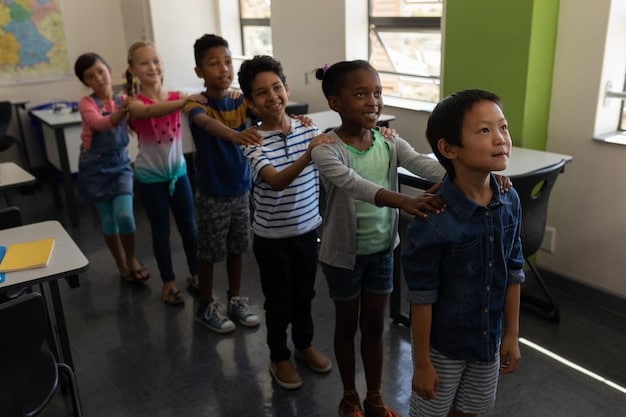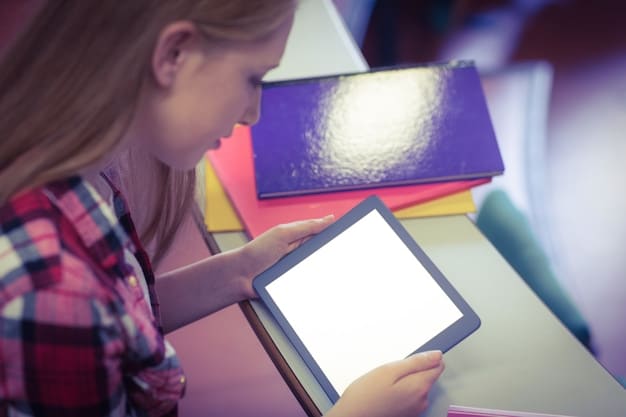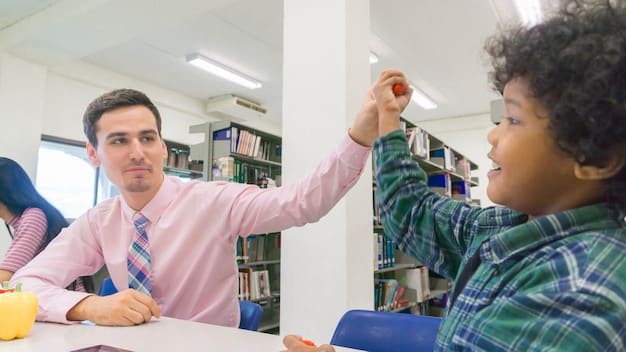Gamification in Education: Proven Strategies to Boost Engagement

Gamification in education leverages game design elements and game principles in learning environments to increase student engagement, motivation, and knowledge retention, creating a more dynamic and effective learning experience.
The classroom is evolving, and traditional methods are no longer enough to capture the attention of today’s students. Gamification in education offers a compelling solution by transforming learning into an engaging and interactive experience. Let’s explore how.
Unlocking the Power of Gamification in Education
Gamification in education is more than just adding fun to learning; it’s about strategically integrating game mechanics into the curriculum to motivate students and enhance their understanding of the subject matter. It’s about turning the educational journey into an exciting quest for knowledge.
By incorporating elements like points, badges, leaderboards, and challenges, educators can tap into students’ intrinsic motivation, encouraging them to actively participate in the learning process and strive for mastery.

Key Elements of Effective Gamification
Successful gamification requires a thoughtful approach that aligns with the learning objectives and considers the needs and interests of the students. Here are the primary elements that contribute to an effective gamified learning environment:
- Clear Learning Objectives: The game mechanics should be directly tied to specific learning outcomes, ensuring that students are acquiring the intended knowledge and skills.
- Engaging Narrative: Create a compelling storyline or theme that immerses students in the learning experience and provides context for the challenges and activities.
- Meaningful Rewards: Offer rewards that are valuable to students, such as points, badges, or virtual currency, and that can be used to unlock additional content or privileges.
- Constructive Feedback: Provide regular feedback that helps students understand their progress, identify areas for improvement, and stay motivated.
Gamification isn’t merely about fun – it’s about creating engaging educational experiences that inspire learning and growth.
Why Gamification Boosts Student Engagement
Student engagement is one of the biggest challenges facing educators today. Gamification’s proven to be an innovative and effective strategy to boost student activity, motivation, and overall performance.
By tapping into elements that naturally motivate students, like competition, challenge, and reward, gamification transforms learning from a passive activity into an active and enjoyable one.
Increased Motivation and Active Participation
Gamification boosts student engagement by providing a compelling learning experience that motivates them to participate actively and pursue their goals. It leverages people’s natural desire for learning and competition to boost motivation.
Students learn to see learning as fun and something to look forward to. Gamification helps students take ownership of their learning.
- Engaging narratives make learning more exciting.
- Points and badges foster a sense of achievement.
- Challenges promote problem-solving skills.
- Leaderboards encourage healthy competition.
Gamification’s motivational factors are essential to keeping students interested, building motivation, and improving educational results.
Proven Gamification Strategies for the Classroom
Implementing gamification in the classroom requires planning and innovative ideas to boost student engagement. Let’s explore some of these strategies and see how impactful they can be.
From incorporating game mechanics to designing educational games, these strategies offer multiple approaches to increase student participation and retention while making learning a fun and rewarding experience.

Points, Badges, and Leaderboards
These are fundamental elements of gamification. Awarding points for completing tasks, earning badges for achievements, and displaying progress on leaderboards can create a sense of accomplishment and competition among students.
It’s important to use leaderboards with care to ensure that they promote healthy competition and don’t discourage students who may be struggling.
Storytelling and Quests
Integrating storytelling and quests can transform the learning experience into an adventure. Presenting lessons as a narrative or series of quests can capture students’ imaginations and make learning more memorable.
Quests can range from simple tasks to complex projects, requiring students to use their knowledge and skills to solve problems and achieve goals.
- Create themed challenges aligned with learning objectives.
- Use narratives to provide context and meaning.
- Incorporate progress bars for student clarity.
- Balance challenge with attainable goals for student motivation.
Gamification strategies should be aligned with educational goals, enhancing engagement and improving understanding of the subject.
Tools and Platforms for Gamified Learning
Numerous tools and platforms are available to support gamified learning, providing educators with resources to create engaging and interactive experiences. Let’s explore some of the popular choices.
From learning management systems (LMS) with gamification features to specialized game-based learning platforms, these tools offer a wide range of options to suit different needs and preferences.
Kahoot!: A game-based learning platform that allows teachers to create quizzes, surveys, and discussions. Students participate using their devices and compete for the highest score.
Classcraft: An LMS that transforms the classroom into a role-playing game. Students earn experience points, gold, and other rewards for positive behavior and academic achievements.
Adapting Gamification for Different Subjects and Age Groups
Gamification can be adapted to suit different subjects and age groups, ensuring that it remains relevant and engaging for all learners. The key is to tailor the game mechanics and rewards to the specific needs and interests of the students.
For younger students, emphasize simple yet engaging games, easy-to-follow rules, and tangible rewards. Engage them with visual learning to get long-lasting educational outcomes.
- Consider student interests and goals when designing activities.
- Ensure that gamified activities align with curriculum standards.
- Use storytelling to increase engagement.
Adapting gamification strategies with students’ age, subject, and learning objectives in mind optimizes the learning experience.
Measuring the Impact of Gamification
Measuring the impact of gamification is essential to determine its effectiveness and identify areas for improvement. Educators can use various metrics to assess the impact of gamification on student behavior, motivation, and performance.
By collecting data on participation rates, completion rates, test scores, and student feedback, teachers can gain insights into the effectiveness of their gamification strategies and make data-driven adjustments to improve learning outcomes.
- Conduct pre- and post-assessments to assess knowledge gains.
- Track completion rates of gamified activities.
- Poll students about their experiences with gamification.
- Review data to determine learning gains.
Measuring the impact of gamification not only demonstrates its value but also enhances teaching methods and improves learning outcomes.
Overcoming Challenges in Gamification Implementation
While gamification offers numerous benefits, implementing it effectively can present challenges. Addressing these challenges is crucial to ensure that gamification strategies are successful and sustainable.
Some common challenges include resistance from students or teachers, lack of resources or training, and difficulty aligning game mechanics with learning objectives. By addressing these issues proactively, educators can maximize the effectiveness of gamification and create a more engaging and rewarding learning experience.
Addressing Technical Issues and Accessibility
Ensuring that gamified learning activities are accessible to all students, regardless of their technical skills or access to technology, is essential. Educators should choose platforms and tools that are user-friendly and compatible with a variety of devices.
They should also provide training and support to students and teachers to help them overcome any technical challenges they may encounter.
- Provide training and support to teachers and students.
- Seek feedback from users to identify areas for improvement.
- Have alternative strategies.
By addressing the challenges to implementation, educators can guarantee that gamification is effective and engaging, promoting positive educational results.
| Key Element | Brief Description |
|---|---|
| 🎯 Learning Objectives | Clearly define what students should learn from the gamified activities. |
| 🏆 Rewards | Offer incentives like points and badges to motivate and reward students. |
| 📊 Feedback | Provide regular and constructive feedback to help students track progress and improve. |
| 🧑🏫 Adaptability | Adjust gamification strategies to suit different subjects, age groups, and learning styles. |
Frequently Asked Questions About Gamification in Education
▼
Gamification in education involves incorporating game design elements like points, badges, and leaderboards into the learning environment to increase student engagement and motivation.
▼
Gamification makes learning more interactive and fun, tapping into students’ intrinsic motivation by providing rewards and a sense of achievement, leading to greater participation.
▼
Yes, gamification can be adapted for various subjects and age groups by tailoring the game mechanics and rewards to match the learning objectives and student interests.
▼
Popular tools include Kahoot!, which creates interactive quizzes; Classcraft, which turns a classroom into a role-playing game; and various LMS platforms with integrated gamification features.
▼
Educators can measure success by tracking participation rates, completion rates, test scores, and collecting student feedback. This data helps assess the impact on learning outcomes.
Conclusion
In conclusion, gamification in education presents a powerful approach to boost student engagement and improve learning outcomes. By incorporating game mechanics and strategies, educators can create a dynamic and rewarding learning environment that motivates students to excel. Embracing gamification can transform the educational experience, making learning more fun, effective, and relevant for the next generation.





